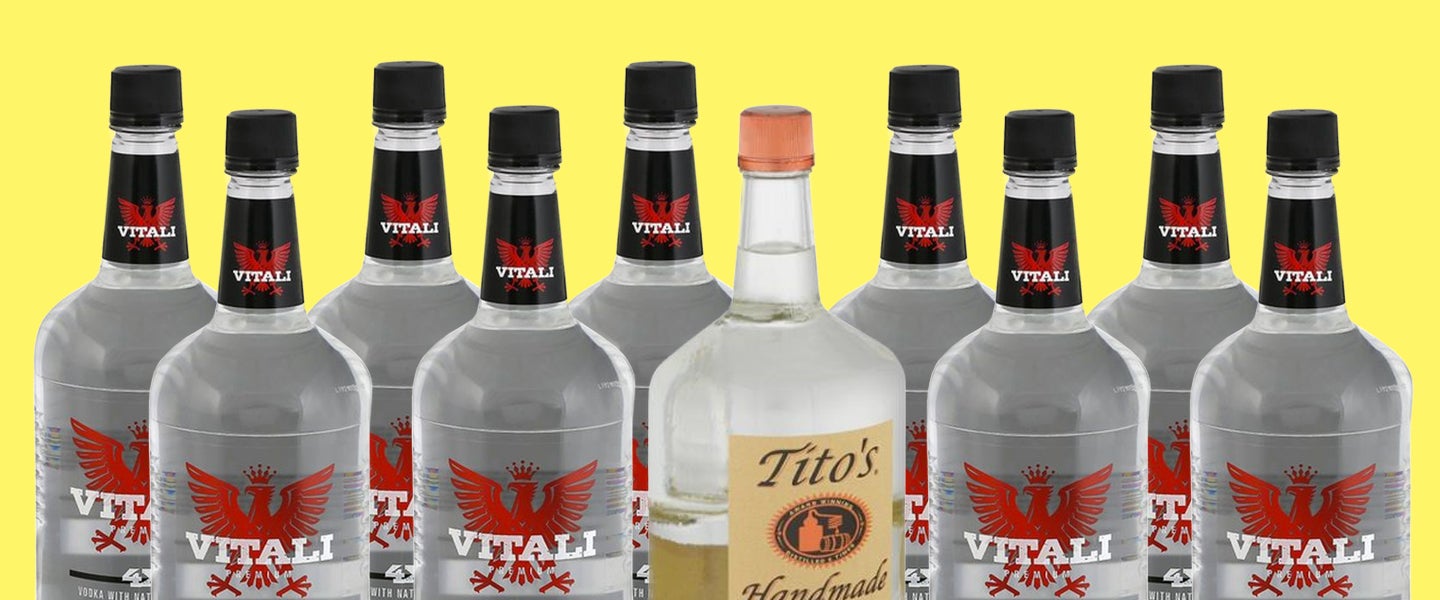If you buy Grey Goose, you’re literally the biggest sucker on the planet. Grey Goose drinkers will be the first to meet the guillotine, guaranteed. I like a “nicer” vodka every now and then — Tito’s is my first choice, if I’m feeling a little spendy. Most days, though, I’m not, and the $10 handle of Trader Joe’s “Vodka of the Gods” seems to serve me just as well. I don’t think I could even tell the difference between Tito’s and the plastic variety, head to head. There’s a general idea that cheap booze, the kind that’s sold in plastic bottles, is going to give you a worse hangover, but that’s not true across the board — at any price point, not all liquors are created equal.
First off, the plastic itself doesn’t change anything about the taste of the liquor, though it can reduce the shelf life. Plastic is a little cheaper than glass to produce, but it’s also easier to transport and won’t break. Even Tito’s sells plastic options in their smaller sizes. There’s still a correlation between the material of a container and the quality of its contents, but only to a small extent.
Dark liquors are thought to be more prone to deliver a hangover because they contain more congeners, or impurities. In whiskey, for example, congeners help provide the distinct color and taste, and can also be the result of less filtration among cheaper varieties. This might mean your body has a more difficult time processing it, which is partially what causes a hangover. Vodka contains fewer congeners by nature, as it’s intended to be purely ethanol and water. However, impurities can still slip in there, which is why brands like Tito’s tout that their beverage is filtered six times.
Thing is, there are plenty of cheaper vodkas that are filtered just as thoroughly, and there’s little evidence to suggest that there’s any true difference either way. A study conducted by NPR’s All Things Considered determined no detectable difference between Grey Goose, bottom-shelf vodka and a homemade kind. The nitty-gritty of the distillation process can make a difference in taste, but again, there’s no clear evidence that it’s chemically any different. Filtering a shitty vodka once or twice, even if you just do it yourself with some activated charcoal and a coffee filter, is apparently enough to improve the taste, if it’s a problem for you.
Beyond the light versus dark liquor disparity, one true issue with cheap booze is sugar. Plain liquors won’t contain any, but some flavored varieties might. Fireball, for example, contains 11 grams of sugar per 1.5 ounce shot. That’s okay for a drink or two, but more than that and you’ll be waaaay over your daily sugar limit, and you’ll definitely feel a lot worse in the morning because of it. Besides the sugar in the liquors themselves, you’re probably more inclined to use sugar-filled mixers to cover up what you perceive to be bad-tasting booze, and with that sugar-filled mixer, you might end up drinking a lot more booze than you would if you were just drinking straight liq.
With tequila, the sugar issue is complicated. Unless it says “100 percent blue agave” on the label, it’s probably actually around 49 percent filler, including stuff like cane sugar. This doesn’t mean the tequila itself actually has sugar in it, but that it’s likely not very pure. Further, like other dark liquors, aged tequilas like reposados or anejos may contain more congeners than blanco as a result of the aging process.
Bottom line, drinking too much of any type of alcohol is gonna make you feel like shit. Plastic bottle whiskey might contain more congeners than the higher-end stuff, but there’s no proof that Mr. Boston is any worse than Stoli. It’s all bad for you. So drink whatever you like, but don’t judge me for saving a few bucks by opting for the cheaper stuff.

